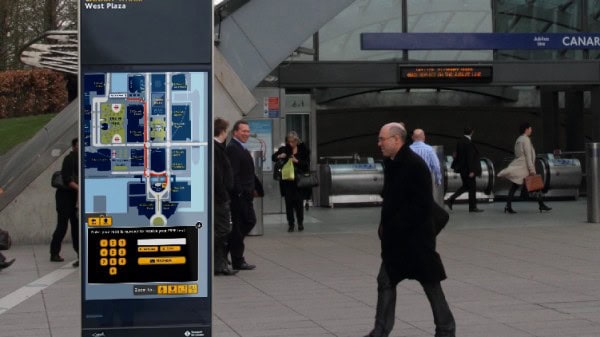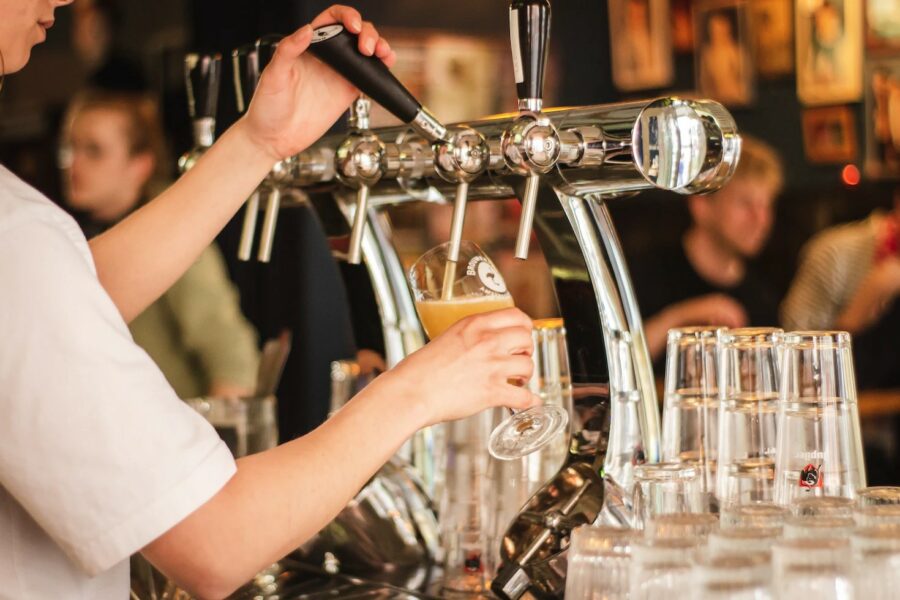Let’s get real: these days, everyone has all the information they need right in their pocket. With mobile phones offering instant access to navigation, reviews, and personalized travel guides, wayfinding kiosks have become outdated before they even have a chance to take off. For Destination Marketing Organizations (DMOs), investing in wayfinding kiosks may seem like a helpful addition to tourist infrastructure, but in reality, they often come with more challenges than benefits. In this article, we’ll break down five reasons why wayfinding kiosks may not be the best option for DMOs and how they can sometimes be a liability instead of a solution.

Clunky Kiosk Blocking Most of a Sidewalk
In today’s world, tourists and travelers rely heavily on their smartphones for all their navigation needs. With apps like Google Maps, Apple Maps, and various travel-specific tools available at the tap of a finger, the role of wayfinding kiosks has diminished significantly. Most visitors prefer the ease of pulling up directions, restaurant recommendations, and hotel bookings directly on their phones rather than stopping at a physical kiosk. This trend renders kiosks less effective in engaging tourists, who have grown accustomed to immediate and personalized information on their devices.
For DMOs, this means that the resources spent on installing and maintaining wayfinding kiosks could be better used in developing mobile-friendly websites, apps, or social media engagement strategies that provide real-time information tailored to visitors’ needs. These digital tools allow for dynamic updates and offer far greater flexibility, reaching a much larger audience.

2. High Initial Costs and Long-Term Maintenance
The financial burden of installing and maintaining wayfinding kiosks is one of the biggest challenges for DMOs. The durability of an indoor kiosk will surprise you as well. While the initial purchase and setup can be expensive, the ongoing maintenance costs are equally high. Outdoor kiosks are subject to weather damage, vandalism, and regular wear and tear, requiring consistent repairs and upgrades to keep them functioning optimally. On top of that, software updates and content management are additional ongoing costs that DMOs must consider.
Rather than investing in kiosks that need constant attention, these resources could be redirected to digital tools that require less upkeep and provide a broader impact. Digital solutions can be updated instantaneously, without the need for physical repairs or upgrades. In an era where budget efficiency is paramount, wayfinding kiosks often represent an outdated and costly solution for DMOs.

3. RFP Processes and Lengthy Production Times
Purchasing and installing wayfinding kiosks often requires going through a long and complicated process. Most DMOs must issue a Request for Proposal (RFP) to find the right vendor to build and install the kiosks. This process can take months, with various stages of approvals, reviews, and negotiations. Once a vendor is chosen, the production timeline can stretch up to a year, especially if the kiosks need to be custom-built for a specific location or purpose.
To make matters worse, the production of these kiosks is often outsourced to international manufacturers. This means that any delays caused by international shipping conflicts, such as port issues or geopolitical tensions, can further push back the installation date. Moreover, if there is an issue with the hardware, DMOs may find themselves in a difficult situation—returning faulty equipment to the manufacturer can be legally complicated, especially if the parts are shipped from countries like China. In the end, the long production timelines and potential legal headaches can be a significant drawback for DMOs looking for a timely and efficient solution.

4. Outdated Information and Slow Updates
One of the most common problems with wayfinding kiosks is that they are static systems. Once installed, their information can quickly become outdated, especially in fast-moving tourist destinations where restaurants, attractions, or events can change frequently. Updating the content on a kiosk often requires manual software updates, which are not immediate and can result in tourists receiving incorrect or outdated information.
In contrast, digital platforms like apps or websites can be updated in real time, ensuring that visitors always have access to the most current information. With mobile tools, DMOs can push updates instantly, keeping tourists informed of any changes to local events, attractions, or transportation. Wayfinding kiosks, by comparison, are slow to adapt, leading to frustrated tourists who may lose trust in the accuracy of the information being provided.

5. Lack of Personalized Visitor Experience
Modern tourists expect a personalized experience that caters to their unique preferences and interests. Unfortunately, wayfinding kiosks are inherently limited in their ability to provide this level of customization. They typically offer one-size-fits-all information that doesn’t take into account the user’s past behavior, preferences, or travel history.
Digital platforms, on the other hand, allow for personalized recommendations. Apps and websites can analyze a user’s search history, location, and preferences to offer tailored suggestions, making the experience more relevant and engaging for the traveler. This personalized experience is becoming the new standard in tourism, and wayfinding kiosks simply cannot compete with the flexibility and customization offered by mobile technology.

6. Environmental and Sustainability Concerns
As sustainability becomes an increasingly important focus for travelers and DMOs alike, wayfinding kiosks can be seen as an outdated solution that doesn’t align with environmental goals. The production, shipping, and installation of kiosks require significant resources, and their ongoing need for electricity and potential repairs adds to their environmental footprint. Moreover, some kiosks still rely on paper maps or printed guides, contributing to unnecessary waste.
For DMOs focused on promoting eco-friendly travel options, wayfinding kiosks can be at odds with sustainability initiatives. Digital solutions, by contrast, have a minimal environmental impact and can often be updated and maintained remotely, reducing the need for physical materials and energy consumption. By opting for more sustainable technologies, DMOs can align themselves with the growing demand for environmentally responsible travel experiences.
Conclusion: Why Wayfinding Kiosks Are a Bad Investment for DMOs
In an age where mobile technology dominates how travelers navigate, wayfinding kiosks are quickly becoming obsolete. They offer limited reach, are costly to maintain, and cannot keep up with the rapid pace of change in the tourism industry. For DMOs looking to provide tourists with a seamless and engaging experience, investing in digital platforms and mobile apps is a far more effective strategy.
With personalized recommendations, real-time updates, and a broader reach, digital tools offer the flexibility and efficiency that modern tourists expect. In contrast, wayfinding kiosks are slow, static, and outdated—an investment that’s better left in the past. By focusing on more dynamic solutions, DMOs can ensure they are meeting the needs of today’s tech-savvy travelers while optimizing their budgets for long-term success.
